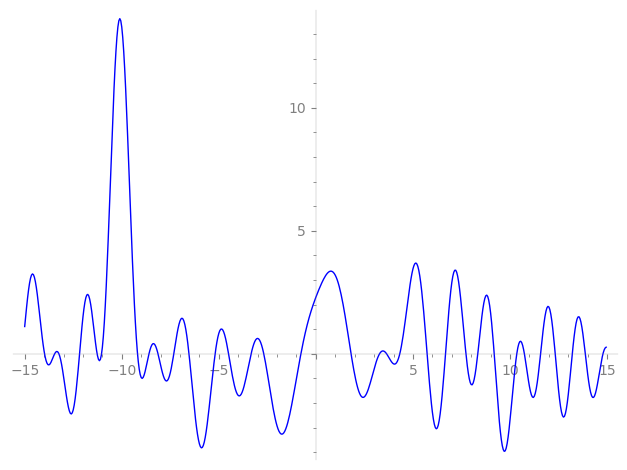| L(s) = 1 | + (0.866 + 0.5i)2-s + (1.60 − 0.923i)3-s + (0.499 + 0.866i)4-s + (−2.80 − 1.61i)5-s + 1.84·6-s + 0.999i·8-s + (0.207 − 0.358i)9-s + (−1.61 − 2.80i)10-s + (−2.04 − 2.60i)11-s + (1.60 + 0.923i)12-s + 6.10·13-s − 5.98·15-s + (−0.5 + 0.866i)16-s + (−4.06 − 7.04i)17-s + (0.358 − 0.207i)18-s + (3.30 − 5.72i)19-s + ⋯ |
| L(s) = 1 | + (0.612 + 0.353i)2-s + (0.923 − 0.533i)3-s + (0.249 + 0.433i)4-s + (−1.25 − 0.723i)5-s + 0.754·6-s + 0.353i·8-s + (0.0690 − 0.119i)9-s + (−0.511 − 0.886i)10-s + (−0.617 − 0.786i)11-s + (0.461 + 0.266i)12-s + 1.69·13-s − 1.54·15-s + (−0.125 + 0.216i)16-s + (−0.986 − 1.70i)17-s + (0.0845 − 0.0488i)18-s + (0.758 − 1.31i)19-s + ⋯ |
\[\begin{aligned}\Lambda(s)=\mathstrut & 1078 ^{s/2} \, \Gamma_{\C}(s) \, L(s)\cr =\mathstrut & (0.325 + 0.945i)\, \overline{\Lambda}(2-s) \end{aligned}\]
\[\begin{aligned}\Lambda(s)=\mathstrut & 1078 ^{s/2} \, \Gamma_{\C}(s+1/2) \, L(s)\cr =\mathstrut & (0.325 + 0.945i)\, \overline{\Lambda}(1-s) \end{aligned}\]
Particular Values
| \(L(1)\) |
\(\approx\) |
\(2.305134054\) |
| \(L(\frac12)\) |
\(\approx\) |
\(2.305134054\) |
| \(L(\frac{3}{2})\) |
|
not available |
| \(L(1)\) |
|
not available |
\(L(s) = \displaystyle \prod_{p} F_p(p^{-s})^{-1} \)
| $p$ | $F_p(T)$ |
|---|
| bad | 2 | \( 1 + (-0.866 - 0.5i)T \) |
| 7 | \( 1 \) |
| 11 | \( 1 + (2.04 + 2.60i)T \) |
| good | 3 | \( 1 + (-1.60 + 0.923i)T + (1.5 - 2.59i)T^{2} \) |
| 5 | \( 1 + (2.80 + 1.61i)T + (2.5 + 4.33i)T^{2} \) |
| 13 | \( 1 - 6.10T + 13T^{2} \) |
| 17 | \( 1 + (4.06 + 7.04i)T + (-8.5 + 14.7i)T^{2} \) |
| 19 | \( 1 + (-3.30 + 5.72i)T + (-9.5 - 16.4i)T^{2} \) |
| 23 | \( 1 + (-2.65 + 4.59i)T + (-11.5 - 19.9i)T^{2} \) |
| 29 | \( 1 + 1.32iT - 29T^{2} \) |
| 31 | \( 1 + (-2.03 + 1.17i)T + (15.5 - 26.8i)T^{2} \) |
| 37 | \( 1 + (2.64 - 4.57i)T + (-18.5 - 32.0i)T^{2} \) |
| 41 | \( 1 + 1.22T + 41T^{2} \) |
| 43 | \( 1 - 3.73iT - 43T^{2} \) |
| 47 | \( 1 + (1.47 + 0.853i)T + (23.5 + 40.7i)T^{2} \) |
| 53 | \( 1 + (-1.99 - 3.44i)T + (-26.5 + 45.8i)T^{2} \) |
| 59 | \( 1 + (7.82 - 4.51i)T + (29.5 - 51.0i)T^{2} \) |
| 61 | \( 1 + (-4.27 + 7.41i)T + (-30.5 - 52.8i)T^{2} \) |
| 67 | \( 1 + (1.17 + 2.03i)T + (-33.5 + 58.0i)T^{2} \) |
| 71 | \( 1 + 7.17T + 71T^{2} \) |
| 73 | \( 1 + (-5.49 - 9.51i)T + (-36.5 + 63.2i)T^{2} \) |
| 79 | \( 1 + (-7.34 - 4.24i)T + (39.5 + 68.4i)T^{2} \) |
| 83 | \( 1 - 5.60T + 83T^{2} \) |
| 89 | \( 1 + (-4.03 - 2.33i)T + (44.5 + 77.0i)T^{2} \) |
| 97 | \( 1 - 3.82iT - 97T^{2} \) |
| show more | |
| show less | |
\(L(s) = \displaystyle\prod_p \ \prod_{j=1}^{2} (1 - \alpha_{j,p}\, p^{-s})^{-1}\)
Imaginary part of the first few zeros on the critical line
−9.187763066696678451900366339668, −8.597273633498227712953109464138, −8.133435526651461663562606784315, −7.32053603189771507407690203250, −6.53735479138092404667959982935, −5.19062239057202807343025890948, −4.49931987296736069789618636712, −3.33700142314197226470292661570, −2.68555863164704608171677718251, −0.77269130955830644649792990444,
1.81143762114367535927371728006, 3.27736152786095064222703183077, 3.64157692891607798252249031345, 4.32068931045697770198065183825, 5.72747763506985006627470183824, 6.67543060669812766691711311560, 7.72881510166483725072429232484, 8.338065411408778771439385765692, 9.183376058238148155877397235485, 10.34715934733799197376026851922

